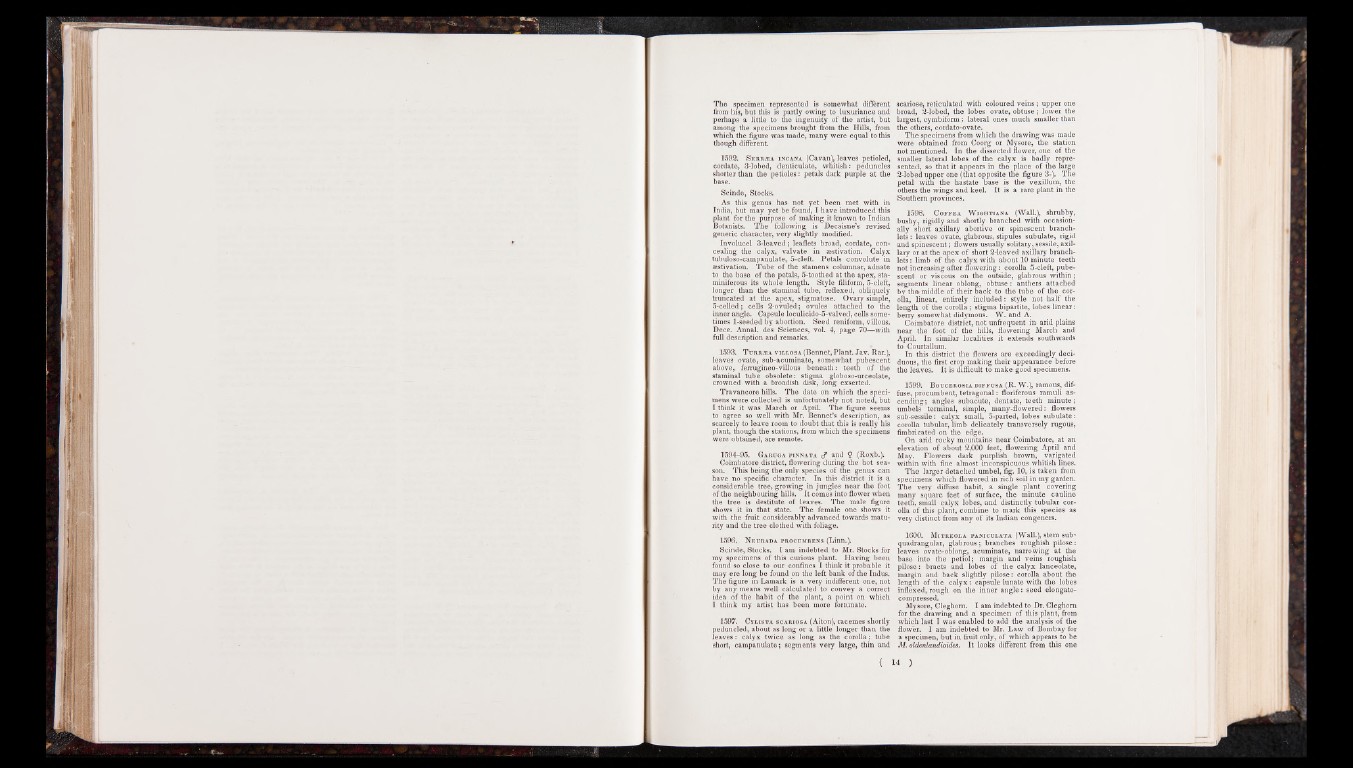
The specimen represented is somewhat different
from his, but this is partly owing to luxuriance and
perhaps a little to the ingenuity of the artist, but
among the specimens brought from the Hills, from
which the figure was made, many were equal to this
though different
1592. Serr^ a incana (Cavan), leaves petioled,
cordate, 3-lobed, denticulate, whitish: peduncles
shorter than the petioles: petals dark purple at the
base.
Scinde, Stocks.
As this genus has not yet been met with in
India, but may yet be found, I have introduced this
plant for the purpose of making it known to Indian
Botanists. The following is Decaisne’s revised
generic character, very slightly modified.
Involucel 3-leaved; leaflets broad, cordate, concealing
the calyx, valvate in aestivation. Calyx
tubuloso-campanulate, 5-cleft. Petals convolute in
aestivation. Tube of the stamens columnar, adnate
to the base of the petals, 5-toothed at the apex, sta-
miniferous its whole length. Style filiform, 5-cleft,
longer than the stamina! tube, reflexed, obliquely
truncated at the apex, stigmatose. Ovary simple,
5-celled; cells 2-ovuled; ovules attached to the
inner angle. Capsule loculicido-5-valved, cells sometimes
1-seeded by abortion. Seed reniform, villous.
Dece. Annal. des Sciences, vol. 4, page 70—with
full description and remarks.
1593. TuRRiEA viliiOsa (Bennet, Plant. Jav. Rar.),
leaves ovate, sub-acuminate, somewhat pubescent
above, ferrugineo-villous beneath: teeth of the
staminal tube obsolete: stigma globoso-urceolate,
crowned with a broadish disk, long exserted.
Travancore hills. The date on which the specimens
were collected is unfortunately not noted, but
I think it was March or April. The figure seems
to agree so well with Mr. Bennet’s description, as
scarcely to leave room to doubt that this is really his
plant, though the stations, from which the specimens
were obtained, are remote.
1594-95. Garuga pinnata c? and 9 (Roxb.).
Coimbatore district, flowering during the hot season.
This being the only species of the genus can
have no specific character. In this district it is a
considerable tree, growing in jungles near the foot
of the neighbouring hills. It comes into flower when
the tree is destitute of leaves. The male figure
shows it in that state. The female one shows it
with the fruit .considerably advanced towards maturity
and the tree clothed with foliage.
1596. N eurada procumbens (Linn.).
Scinde, Stocks. I am indebted to Mr. Stocks for
my specimens of this curious plant. Having been
found so close to our confines I think it probable it
may ere long be found on the left bank of the Indus.
The figure in Lamark is a very indifferent one, not
by any means well calculated to convey a correct
idea of the habit of the plant, a point on which
I think my artist has been more fortunate.
1597. Cylista scariosa (Aiton), racemes shortly
peduncled, about as long or a little longer than the
leaves: calyx twice as long as the corolla; tube
short, campanulate; segments very large, thin and
scariose, reticulated with coloured veins; upper one
broad, 2-lobed, the lobes ovate, obtuse; lower the
largest, cymbiform; lateral ones much smaller than
the others, cordato-ovate.
The specimens from which the drawing was made
were obtained from Coorg or Mysore, the station
not mentioned. In the dissected flower, one of the
smaller lateral lobes of the calyx is badly represented,
so that it appears in the place of the large
2-lobed upper one (that opposite the figure 3-). Tne
petal with the hastate base is the vexillum, the
others the wings and keel. It is a rare plant in the
Southern provinces.
1598. Coffea Wightiana (Wall.), shrubby,
bushy, rigidly and shortly branched with occasionally
short axillary abortive or spinescent branch-
lets: leaves ovate, glabrous, stipules subulate, rigid
and spinescent; flowers usually solitary, sessile, axillary
or at the apex of short 2-leaved axillary branch-
lets: limb of the calyx with about 10 minute teeth
not increasing after flowering: corolla 5-cleft, pubescent
or viscous on the outside, glabrous within;
segments linear oblong, obtuse: anthers attached
by the* middle of their back to the tube of the corolla,
linear, entirely included: style not half the
length of the corolla; stigma bipartite, lobes linear:
berry somewhat didymous. W. and A.
Coimbatore district, not unfrequent in arid plains
near the foot of the hills, flowering March and
April. In similar localities it extends southwards
to Courtallum.
In this district the flowers are exceedingly deciduous,
the first crop making their appearance before
the leaves. It is difficult to make good specimens.
1599. B oucerosia diffusa (R. W.), ramous, diffuse,
procumbent, tetragonal: floriferous ramuli ascending
; angles subacute, dentate, teeth minute;
umbels terminal, simple, many-flowered: flowers
sub-sessile: calyx small, 5-parted, lobes subulate:
corolla tubular, limb delicately transversely rugous,
fimbricated on the edge.
On arid rocky mountains near Coimbatore, at an
elevation of about 2,000 feet, flowering April and
May. Flowers dark purplish brown, varigated
within with fine almost inconspicuous whitish Tines.
The larger detached umbel, fig. 10, is taken from
specimens which flowered in rich soil in my garden.
The very diffuse habit, a single plant covering
many square feet of surface, the minute cauline
teeth, small calyx lobes, and distinctly tubular corolla
of this plant, combine to mark this species as
very distinct from any of its Indian congeners.
1600. Mitreola paniculata (Wall.), stem sub-
quadrangular, glabrous; branches rougnish pilose:
leaves ovate-oblong, acuminate, narrowing at the
base into the petiol; margin and veins roughish
pilose: bracts and lobes of the calyx lanceolate,
margin and back slightly pilose: corolla about the
length of the ca ly x : capsule lunate with the lobes
inflexed, rough on the inner angle: seed elongato-
compressed.
Mysore, Cleghorn. I am indebted to Dr. Cleghorn
for the drawing and a specimen of this plant, from
which last I was enabled to add the analysis of the
flower. I am indebted to Mr. Law of Bombay for
a specimen, but in fruit only, of which appears to be
M. oldenlandioides. It looks different from this one
( ■ )